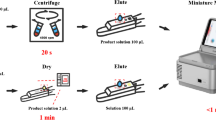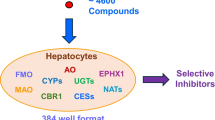Abstract
Cocktail phenotyping using specific probe drugs for cytochrome P450 (CYP) enzymes provides information on the real-time activity of multiple CYPs. We investigated different sample preparation techniques and validated a liquid chromatography-tandem mass spectrometry (LC-MS/MS) method with simple protein precipitation for the analysis of nine CYP probe drugs and their metabolites in human serum and urine. Specific CYP probe drugs (melatonin, CYP1A2; nicotine, CYP2A6; bupropion, CYP2B6; repaglinide, CYP2C8; losartan, CYP2C9; omeprazole, CYP2C19 and CYP3A4; dextromethorphan, CYP2D6; chlorzoxazone, CYP2E; midazolam, CYP3A4) and their main metabolites, with the exception of 3′-hydroxyrepaglinide, were quantified in human serum and urine using the developed LC-MS/MS method. The analytical method was fully validated showing high selectivity, linearity, acceptable accuracy (85–115 %) and precision (2–19 %) and applied to a pharmacokinetic study in four healthy volunteers after oral administration of drugs given as a cocktail. All probe drugs and their metabolites (totally 19 analytes) were detected and quantified from human serum and urine over the time range of 1 to 6 h after oral administration. Therefore, the proposed method is applicable for drug interaction and CYP phenotyping studies utilizing a cocktail approach.

Workflow overwiew of cocktail CYP-phenotyping study



Similar content being viewed by others
References
Guengerich FP. Cytochrome P450 and chemical toxicology. Chem Res Toxicol. 2008;21:70–83.
Gonzalez FJ, Tukey RH. Drug metabolism. In: Brunton LL, Lazo JS, Parker KL, editors. Goodman & Gilman’s the pharmacological basis of therapeutics. New York: McGraw Hill; 2006. p. 71–91.
Breimer DD. Interindividual variations in drug disposition. clinical implications and methods of investigation. Clin Pharmacokinet. 1983;8:371–7.
Bosilkovska M, Samer CF, Déglon J, Rebsamen M, Staub C, Dayer P, et al. Geneva cocktail for cytochrome P450 and P-glycoprotein activity assessment using dried blood spots. Clin Pharmacol Ther. 2014;96:349–59.
de Andrés F, Terán S, Bovera M, Fariñas H, Terán E, LLerena A. Multiplex phenotyping for systems medicine: a one-point optimized practical sampling strategy for simultaneous estimation of CYP1A2, CYP2C9, CYP2C19, and CYP2D6 activities using a cocktail approach. OMICS. 2016;20:88–96.
Donzelli M, Derungs A, Serratore MG, Noppen C, Nezic L, Krähenbühl S, et al. The basel cocktail for simultaneous phenotyping of human cytochrome P450 isoforms in plasma, saliva and dried blood spots. Clin Pharmacokinet. 2014;53:271–82.
Chainuvati S, Nafziger AN, Leeder JS, Gaedigk A, Kearns GL, Sellers E, et al. Combined phenotypic assessment of cytochrome P450 1A2, 2C9, 2C19, 2D6, and 3A, N-acetyltransferase-2, and xanthine oxidase activities with the “Cooperstown 5 + 1 cocktail”. Clin Pharmacol Ther. 2003;74:437–47.
Christensen M, Andersson K, Dalén P, Mirghani RA, Muirhead GJ, Nordmark A, et al. The Karolinska cocktail for phenotyping of five human cytochrome P450 enzymes. Clin Pharmacol Ther. 2003;73:517–28.
Sharma A, Pilote S, Bélanger PM, Arsenault M, Hamelin BA. A convenient five-drug cocktail for the assessment of major drug metabolizing enzymes: a pilot study. Br J Clin Pharmacol. 2004;58:288–97.
Streetman DS, Bleakley JF, Kim JS, Nafziger AN, Leeder JS, Gaedigk A, et al. Combined phenotypic assessment of CYP1A2, CYP2C19, CYP2D6, CYP3A, N-acetyltransferase-2, and xanthine oxidase with the “Cooperstown cocktail”. Clin Pharmacol Ther. 2000;68:375–83.
Fuhr U, Jetter A, Kirchheiner J. Appropriate phenotyping procedures for drug metabolizing enzymes and transporters in humans and their simultaneous use in the “cocktail” approach. Clin Pharmacol Ther. 2007;81:270–83.
Turpault S, Brian W, Horn RV, Santoni A, Poitiers F, Donazzolo Y, et al. Pharmacokinetic assessment of a five-probe cocktail for CYPs 1A2, 2C9, 2C19, 2D6 and 3A. Br J Clin Pharmacol. 2009;68:928–35.
de Andrés F, Sosa-Macías M, Llerena A. A rapid and simple LC-MS/MS method for the simultaneous evaluation of CYP1A2, CYP2C9, CYP2C19, CYP2D6 and CYP3A4 hydroxylation capacity. Bioanalysis. 2014;6:683–96.
Bosilkovska M, Déglon J, Samer C, Walder B, Desmeules J, Staub C, et al. Simultaneous LC-MS/MS quantification of P-glycoprotein and cytochrome P450 probe substrates and their metabolites in DBS and plasma. Bioanalysis. 2014;6:151–64.
Tanaka S, Uchida S, Inui N, Takeuchi K, Watanabe H, Namiki N. Simultaneous LC-MS/MS analysis of the plasma concentrations of a cocktail of 5 cytochrome P450 substrate drugs and their metabolites. Biol Pharm Bull. 2014;37:18–25.
Petsalo A, Turpeinen M, Pelkonen O, Tolonen A. Analysis of nine drugs and their cytochrome P450-specific probe metabolites from urine by liquid chromatography-tandem mass spectrometry utilizing sub 2 microm particle size column. J Chromatogr A. 2008;1215:107–15.
European Medicines Agency. Guideline on the validation of bioanalytical methods. London: Committee for Proprietary Medicinal Products for Human use (CHMP); 2011. http://www.ema.europa.eu/docs/en_GB/document_library/Scientific_guideline/2011/08/WC500109686.pdf.
Krösser S, Neugebauer R, Dolgos H, Fluck M, Rost KL, Kovar A. Investigation of sarizotan’s impact on the pharmacokinetics of probe drugs for major cytochrome P450 isoenzymes: a combined cocktail trial. Eur J Clin Pharmacol. 2006;62:277–84.
Tomalik-Scharte D, Jetter A, Kinzig-Schippers M, Skott A, Sörgel F, Klaassen T, et al. Effect of propiverine on cytochrome P450 enzymes: a cocktail interaction study in healthy volunteers. Drug Metab Dispos. 2005;33:1859–66.
Säll C, Houston JB, Galetin A. A comprehensive assessment of repaglinide metabolic pathways: impact of choice of in vitro system and relative enzyme contribution to in vitro clearance. Drug Metab Dispos. 2012;40:1279–89.
Yasar Ü, Eliasson E, Forslund-Bergengren C, Tybring G, Gadd M, Sjöqvist F, et al. The role of CYP2C9 genotype in the metabolism of diclofenac in vivo and in vitro. Eur J Clin Pharmacol. 2001;57:729–35.
Yasar Ü, Tybring G, Hidestrand M, Oscarson M, Ingelman-Sundberg M, Dahl ML, et al. The role of CYP2C9 polymorphism in losartan oxidation. Drug Metab Dispos. 2001;29:1051–6.
European Medicines Agency. Guideline on the investigation of drug interactions. http://www.ema.europa.eu/docs/en_GB/document_library/Scientific_guideline/2012/07/WC500129606.pdf.
Blakey GE, Lockton JA, Perrett J, Norwood P, Russell M, Aherne Z, et al. Pharmacokinetic and pharmacodynamic assessment of a five-probe metabolic cocktail for CYPs 1A2, 3A4, 2C9, 2D6 and 2E1. Br J Clin Pharmacol. 2004;57:162–9.
Ryu JY, Song IS, Sunwoo YE, Shon JH, Liu KH, Cha IJ, et al. Development of the “Inje cocktail” for high-throughput evaluation of five human cytochrome P450 isoforms in vivo. Clin Pharmacol Ther. 2007;82:531–40.
Zhou SF, Wang B, Yang LP, Liu JP. Structure, function, regulation and polymorphism and the clinical significance of human cytochrome P450 1A2. Drug Metab Rev. 2010;42:268–354.
Dempsey D, Tutka P, Jacob 3rd P, Allen F, Schoedel K, Tyndale RF, et al. Nicotine metabolite ratio as an index of cytochrome P450 2A6 metabolic activity. Clin Pharmacol Ther. 2004;76:64–72.
Raunio H, Rahnasto-Rilla M. CYP2A6: genetics, structure, regulation, and function. Drug Metabol Drug Interact. 2012;27:73–88.
Acknowledgments
The authors thankfully acknowledge Ms Pirjo Hänninen (School of Pharmacy, University of Eastern Finland) for the excellent technical assistance, Dr. Seppo Auriola for helpful discussions and advice regarding the method validation procedure and M.Sc.Taisiya Bezhaeva for her assistance in preparation of the graphical abstract.
Author information
Authors and Affiliations
Corresponding author
Ethics declarations
The pharmacokinetic study was approved by the Research Ethics Committee of North Savo District Hospital No: 27/2010 and was conducted in accordance with the Declaration of Helsinki. All healthy volunteers gave the informed consent before any study procedures were conducted.
Conflict of interest
The authors declare that they have no conflict of interest.
Electronic supplementary material
Below is the link to the electronic supplementary material.
ESM 1
(PDF 122 kb)
Rights and permissions
About this article
Cite this article
Puris, E., Pasanen, M., Gynther, M. et al. A liquid chromatography-tandem mass spectrometry analysis of nine cytochrome P450 probe drugs and their corresponding metabolites in human serum and urine. Anal Bioanal Chem 409, 251–268 (2017). https://doi.org/10.1007/s00216-016-9994-x
Received:
Revised:
Accepted:
Published:
Issue Date:
DOI: https://doi.org/10.1007/s00216-016-9994-x




